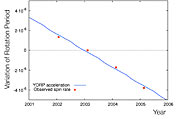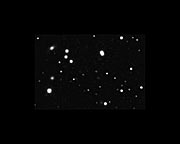Pressmeddelande
Solar Power at Play
Observing the Spin-Up of an Asteroid
7 mars 2007
For the very first time, astronomers have witnessed the speeding up of an asteroid's rotation, and have shown that it is due to a theoretical effect predicted but never seen before. The international team of scientists used an armada of telescopes to discover that the asteroid's rotation period currently decreases by 1 millisecond every year, as a consequence of the heating of the asteroid's surface by the Sun. Eventually it may spin faster than any known asteroid in the solar system and even break apart.
"The Yarkovsky-O'Keefe-Radzievskii-Paddack (YORP) effect is believed to alter the way small bodies in the Solar System rotate," said Stephen Lowry (Queens University Belfast, UK), lead-author of one of the two companion papers in which this work is reported [1] [2].
"The warming caused by sunlight hitting the surfaces of asteroids and meteoroids leads to a gentle recoil effect as the heat is released," he added. "By analogy, if one were to shine light on a propeller over a long enough period, it would start spinning."
Although this is an almost immeasurably weak force, its effect over millions of years is far from negligible. Astronomers believe the YORP effect may be responsible for spinning some asteroids up so fast that they break apart, perhaps leading to the formation of double asteroids. Others may be slowed down so that they take many days to complete a full turn. The YORP effect also plays an important role in changing the orbits of asteroids between Mars and Jupiter, including their delivery to planet-crossing orbits, such as those of near-Earth asteroids. Despite its importance, the effect has never been seen acting on a solar system body, until now.
Using extensive optical and radar imaging from powerful Earth-based observatories, astronomers have directly observed the YORP effect in action on a small near-Earth asteroid, known as (54509) 2000 PH5.
Shortly after its discovery in 2000, it was realised that asteroid 2000 PH5 would be the ideal candidate for such a YORP detection. With a diameter of just 114 metres, it is relatively small and so more susceptible to the effect. Also, it rotates very fast, with one 'day' on the asteroid lasting just over 12 Earth minutes, implying that the YORP effect may have been acting on it for some time. With this in mind, the team of astronomers undertook a long term monitoring campaign of the asteroid with the aim of detecting any tiny changes in its rotation speed.
Over a 4-year time span, Stephen Lowry, Alan Fitzsimmons and colleagues took images of the asteroid at a range of telescope sites including ESO's 8.2-m Very Large Telescope array and 3.5-m New Technology Telescope in Chile, the 3.5-m telescope at Calar Alto, Spain, along with a suite of other telescopes from Czechia, the Canary Islands, Hawaii, Spain and Chile. With these facilities the astronomers measured the slight brightness variations as the asteroid rotated.
Over the same time period, the radar team led by Patrick Taylor and Jean-Luc Margot of Cornell University employed the unique capabilities of the Arecibo Observatory in Puerto Rico and the Goldstone radar facility in California to observe the asteroid by 'bouncing' a radar pulse off the asteroid and analysing its echo.
"With this technique we can reconstruct a 3-D model of the asteroid's shape, with the necessary detail to allow a comparison between the observations and theory," said Taylor.
After careful analysis of the optical data, the asteroid's spin rate was seen to steadily increase with time, at a rate that can be explained by the YORP theory. Critically, the effect was observed year after year, for more than 4 years. Furthermore, this number was elegantly supported via analysis of the combined radar and optical data, as it was required that the asteroid is increasing its spin rate at exactly this rate in order for a satisfactory 3-D shape model to be determined.
To predict what will happen to the asteroid in the future, Lowry and his colleagues performed detailed computer simulations using the measured strength of the YORP effect and the detailed shape model. They found that the orbit of the asteroid about the Sun could remain stable for up to the next 35 million years, allowing the rotation period to be reduced by a factor of 36, to just 20 seconds, faster than any asteroid whose rotation has been measured until now.
"This exceptionally fast spin-rate could force the asteroid to reshape itself or even split apart, leading to the birth of a new double system," said Lowry.
Noter
[1] Stephen C. Lowry, Alan Fitzsimmons, Petr Pravec, David Vokrouhlicky, Hermann Boehnhardt, Patrick A. Taylor, Jean-Luc Margot, Adrian Galad, Mike Irwin, Jonathan Irwin, and Peter Kusnirak (2007). Direct Detection of the Asteroidal YORP Effect, Published online in Science Express.
[2] Patrick A. Taylor, Jean-Luc Margot, David Vokrouhlicky, Daniel J. Scheeres, Petr Pravec, Stephen C. Lowry, Alan Fitzsimmons, Michael C. Nolan, Steven J. Ostro, Lance A. M. Benner, Jon D. Giorgini, Christopher Magri (2007). Spin Rate of Asteroid (54509) 2000 PH5 Increasing due to the YORP Effect, Published online in Science Express.
Kontakter
Stephen Lowry
Astrophysics Research Centre Queen's University Belfast
Belfast, UK
Tel: +44 28 9097-3692
E-post: s.c.lowry@qub.ac.uk
Alan Fitzsimmons
Astrophysics Research Centre Queen's University Belfast
Belfast, UK
Tel: +44 7834-318834
E-post: a.fitzsimmons@qub.ac.uk
Patrick Taylor
Department of Astronomy Cornell University
Ithaca, USA
Tel: +1 607-255-2727
E-post: ptaylor@astro.cornell.edu
Jean-Luc Margot
Department of Astronomy Cornell University
Ithaca, USA
Tel: +1 607-255-1810
E-post: jlm@astro.cornell.edu
Hermann Boehnhardt
Max-Planck Institute for Solar System Research
Katlenburg-Lindau, Germany
Tel: +49 5556-979-545
E-post: boehnhardt@mps.mpg.de
Petr Pravec
Astronomical Institute AS CR
Ondrejov, Czechia
Tel: +420 323-620352
E-post: ppravec@asu.cas.cz
Astronomical Institute AS CR
Ondrejov, Czechia
Tel: +420 737-322815
E-post: suchan@astro.cz
Om pressmeddelandet
| Pressmeddelande nr: | eso0711 |
| Legacy ID: | PR 11/07 |
| Namn: | 54509 YORP, asteroid 2000 PH5 |
| Typ: | Solar System : Interplanetary Body : Asteroid |
| Facility: | New Technology Telescope, Other, Very Large Telescope |
| Instruments: | EMMI, FORS2 |
| Science data: | 2007Sci...316..274T 2007Sci...316..272L |
Our use of Cookies
We use cookies that are essential for accessing our websites and using our services. We also use cookies to analyse, measure and improve our websites’ performance, to enable content sharing via social media and to display media content hosted on third-party platforms.
ESO Cookies Policy
The European Organisation for Astronomical Research in the Southern Hemisphere (ESO) is the pre-eminent intergovernmental science and technology organisation in astronomy. It carries out an ambitious programme focused on the design, construction and operation of powerful ground-based observing facilities for astronomy.
This Cookies Policy is intended to provide clarity by outlining the cookies used on the ESO public websites, their functions, the options you have for controlling them, and the ways you can contact us for additional details.
What are cookies?
Cookies are small pieces of data stored on your device by websites you visit. They serve various purposes, such as remembering login credentials and preferences and enhance your browsing experience.
Categories of cookies we use
Essential cookies (always active): These cookies are strictly necessary for the proper functioning of our website. Without these cookies, the website cannot operate correctly, and certain services, such as logging in or accessing secure areas, may not be available; because they are essential for the website’s operation, they cannot be disabled.
Functional Cookies: These cookies enhance your browsing experience by enabling additional features and personalization, such as remembering your preferences and settings. While not strictly necessary for the website to function, they improve usability and convenience; these cookies are only placed if you provide your consent.
Analytics cookies: These cookies collect information about how visitors interact with our website, such as which pages are visited most often and how users navigate the site. This data helps us improve website performance, optimize content, and enhance the user experience; these cookies are only placed if you provide your consent. We use the following analytics cookies.
Matomo Cookies:
This website uses Matomo (formerly Piwik), an open source software which enables the statistical analysis of website visits. Matomo uses cookies (text files) which are saved on your computer and which allow us to analyze how you use our website. The website user information generated by the cookies will only be saved on the servers of our IT Department. We use this information to analyze www.eso.org visits and to prepare reports on website activities. These data will not be disclosed to third parties.
On behalf of ESO, Matomo will use this information for the purpose of evaluating your use of the website, compiling reports on website activity and providing other services relating to website activity and internet usage.
Matomo cookies settings:
Additional Third-party cookies on ESO websites: some of our pages display content from external providers, e.g. YouTube.
Such third-party services are outside of ESO control and may, at any time, change their terms of service, use of cookies, etc.
YouTube: Some videos on the ESO website are embedded from ESO’s official YouTube channel. We have enabled YouTube’s privacy-enhanced mode, meaning that no cookies are set unless the user actively clicks on the video to play it. Additionally, in this mode, YouTube does not store any personally identifiable cookie data for embedded video playbacks. For more details, please refer to YouTube’s embedding videos information page.
Cookies can also be classified based on the following elements.
Regarding the domain, there are:
- First-party cookies, set by the website you are currently visiting. They are stored by the same domain that you are browsing and are used to enhance your experience on that site;
- Third-party cookies, set by a domain other than the one you are currently visiting.
As for their duration, cookies can be:
- Browser-session cookies, which are deleted when the user closes the browser;
- Stored cookies, which stay on the user's device for a predetermined period of time.
How to manage cookies
Cookie settings: You can modify your cookie choices for the ESO webpages at any time by clicking on the link Cookie settings at the bottom of any page.
In your browser: If you wish to delete cookies or instruct your browser to delete or block cookies by default, please visit the help pages of your browser:
Please be aware that if you delete or decline cookies, certain functionalities of our website may be not be available and your browsing experience may be affected.
You can set most browsers to prevent any cookies being placed on your device, but you may then have to manually adjust some preferences every time you visit a site/page. And some services and functionalities may not work properly at all (e.g. profile logging-in, shop check out).
Updates to the ESO Cookies Policy
The ESO Cookies Policy may be subject to future updates, which will be made available on this page.
Additional information
For any queries related to cookies, please contact: pdprATesoDOTorg.
As ESO public webpages are managed by our Department of Communication, your questions will be dealt with the support of the said Department.




